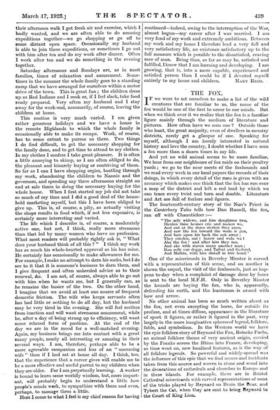THE FOX.
IF we were to set ourselves .to make a list of the wild creatures that are familiar to us, the name of the fox would be one of the first to occur to our minds. But when we.think over it we realize that the.fox is .a familiar figure mainly through the medium of literature and pictures. How often have we seen one ? Outside those who hunt, the great majority, even of dwellers in-country districts, rarely get a glimpse of one. Speaking for myself, although I am keenly interested in natural history and love the country, I doubt whether .I have seen a fox more than a dozen times in my life.
And yet no wild animal seems to be more familiar, We hear from our neighbours of fox raids on their poultry yards ; we go to the near meets -of the foxhounds and we read every week in our local papers the records of their doings, in which every detail of the rims is given with an accuracy which makes one think that the fox has run over a map of the district and left a • red :trail by which we .can trace every twist and turn. and double. Literature and Art are full of foxlore and figures.
The fourteenth-century story of the Nun's Priest in the Canterbury Tales tells how Dan Russell, the fox, .ran off with Chaunticleer :- " The. sely widewe, and hire doughtren two, Herden thise hennes crie and =ken wo, And out at the dores sterten they anon, And- saw the fox toward the wode is goo, And bare-upon his back the. cok away ; They crieden, out I harow and wala wa Aha the fox 1 and after him they ran, And eke with staves many another man ; Ran colle our dogge, and Talbot and Gerlond, And Malkin, with hire distaff in hire' hond."
One of the misericords in Beverley Minster is carved with a representation of this scene, and on another is shown the sequel, the visit of the foxhounds, just as hap- pens to-day when a complaint of damage done by foxes is sent to the local M.F.H. Only in Beverley Minster the hounds are baying the fox, who is, apparently, defending his earth, and -the huntsman is armed with bow and arrow.
No other animal has been so much written about as the fox, not even excepting the horse, for outside its profuse, and at times diffuse, appearance in the literature of sport it figures, or rather it figured in the past, very largely in the more imaginative spheres of legend, folklore, fable, and symbolism. In the Western -world ,we have the epic folklore story of Reynard the Fox, Reineke Fuchs, an animal folklore theme of very ancient origin, carried by the Franks across the Rhine into -France, • developing, as time went on, new localized features, as is the way,Of all folklore legends. So powerful and widely-spread was the influence of this epic that we find scenes and incidents taken from this source and woven in stone and wood into the decorations of cathedrals and churches in Europe and in these islands. For example, there are in Bristol Cathedral misericords with carved representations of some of the tricks played by Reynard on Bruin the Bear, and Tybert the Cat, when they are sent to bring Reynard to the Court of King Lion. From the Near East, probably, came the quaint fancies of animal symbolism in the shape of the Physiologus, the early ecclesiastical Bestiary which has inspired innumer- able church carvings, distorted facts fantastically applied to the symbolism of theological ideas.
It is little wonder that mediaeval woodcarvers indulged so freely in the grotesque inspirations afforded them by these symbolic legends. Innumerable, too, are the examples of the use in the Middle Ages of the fox in a satirical form and directed against the abuses arising from the decay of the early ideals of some of the religious orders. The fox, dressed in the garb of a bishop, an abbot, or a friar, preaching to a congregation of fowls was a favourite and often-recurring subject.
And in the Far East also, in China and Japan, the fox is a prominent figure in folklore and symbolism. Captain Brinkley, in his exhaustive work on Japan, its History, Arts, and Literature, tells us that both the fox and the badger figure largely in the legends and superstitions of the people. The latter animal is generally associated with practical jokes and mischievous tricks rather than with malicious demonology, as is the case with the fox, faith in whose supernatural attributes is most widely entertained. According to popular tradition, the fox can assume human form, and Captain Brinkley says : " There are also weak-minded persons to whose imagina- tions these legends appeal so vividly that they become subjective victims of fox-possession. They bark like a fox, exhibit the utmost aversion to dogs, and otherwise lose their human identity."
How comes the fox to bulk so largely in the human mind ? One reason, perhaps, is that early in the history of mankind the belief grew up that animals and birds possessing marked characteristics were incarnations of . those particular qualities. Even without this belief it is natural that the human mind in seeking types for standards of comparison and of symbolism should select that part of the natural world which shows the fewest variations. Hence in our comparisons we speak of a man being " as timid as a hare " or " as cunning as a fox." The fox is wily and destructive, but somehow he is a popular " rascal." We hunt and kill him when we can, but the countryside would, on the whole, miss











































 Previous page
Previous page